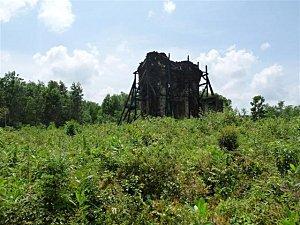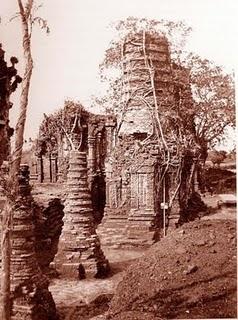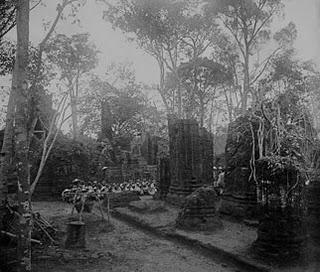
Bereits in der letzten Woche wurde bekannt, dass der Thap Sang, der Eingang eines Turmes in Dong Duong (Đồng Dương), wiederhergestellt werden soll. Thap Sang ist der letzte Rest, der von der stolzen Hauptstadt Indrapura des Cham-Reiches übriggeblieben ist.
König Indravarman II verlegte 875 die Hauptstadt von Simhapura nach Indrapura, dem heutigen Dong Duong, knapp 30 Kilometer südlich von Hoi An in Quang Nam. Er war Buddhist und gründete dort ein buddhistisches Kloster (vihara). Die Gründe für die Verlegung sind aus den Inschriften nicht leicht zu entnehmen- es gibt Autoren, die von einer Indrapura-Dynastie sprechen und demnach einen Wechsel der königlichen Adelsfamilien postulieren. Andere dagegen sprechen eher davon, dass sich Indravarman II der Macht des hinduistischen My Son entziehen wollte. Das buddhistische Interregnum dauerte nicht lange, 915 kehrte der Hof eventuell unter König Bhadravarman III oder Indravarman III nach Simhapura zurück. Vor zwei Jahren habe ich Dong Duong einmal besucht und war entsetzt, wie es dort heute aussieht.
Denn die Zerstörungen sind Folgen des Krieges, nicht der 1000jährigen Dschungelüberwucherung.

Auf den alten Bildern erkennt man, dass die Strukturen durchaus erhalten gewesen sind. Indrapura war nur ein wenig unaufgeräumt, aber sonst durchwegs erhalten. Nach dem Krieg blieb nur eine Mauerwand stehen, der Thap Sang genannte Eingang für einen Turm. Französische Archäologen legten Dong Duong frei. Leider existiert keine grundlegende Studie, man war damals mehr an My Son interessiert. Man wusste damals ja auch nicht, dass Dong Duong einmal dem Erdboden gleichgemacht würde.
Dieser klägliche Rest ist aber auch in Gefahr, denn Taifune und starker Regen nagen an den Ziegeln. Mittlerweile droht er einzustürzen. Denkmalschützer wollen nun diesen kläglichen Mauerrest davor bewahren. Es ist zumindest eine letzte Referenz an die Überreste dieses glanzvollen Königreiches in dieser Region.
Dong Duong ist von großer Bedeutung: Einmal historisch wegen des buddhistischen Interregnums in der sonst eher hinduistisch geprägten Geschichte Champas. Aber vor allem als Kunststil. Der Dong Duong-Stil bildet einen Übergang zu dem herrlichen My Son A1-Stil. In My Son, Gruppe B kann man dies eindrucksvoll beobachten. Dort stehen die Gebäude B5 und B4 nebeneinander –B5 My Son A1-Stil (gemischt mit anderen) und B4 Dong Duong-Stil. 1978 kam bei Grabungen die Bronzefigur einer Tara zum Vorschein. Sie ist heute in Da Nang zu sehen. Sie gehört zu den bedeutendsten Bronzestatuen der Champa-Kunst.
=================================
Last week authorities told that Thap Sang, the entrance of a tower in Dong Duong, should be reconstructed soon. Thap Sang is the last rest of the past capital of Indrapura of the Champa Kingdom.
King Indravarman II moved the capital in 875 from Simhapura to Indrapura, the today Dong Duong, approximately 30 kilometres south of Hoi An in Quang Nam Province. He was Buddhist and founded a Buddhist cloister (vihara). The reasons for the move are not quite clear after reading the inscriptions, because they don’t tell us. Some historians mention a new dynasty and think of a change in the imperial line. Others say Indravarman II as Buddhist wanted flea the influence of hinduist My Son. This Buddhist interregnum did not last long – in 915 king Bhadravarman III or King Indravarman III moved back to Simhapura. Two years ago I visited Dong Duong and was really upset about the condition of this site.
The destruction is a result of war, not of the 1000 years of jungle occupation.

On the pictures taken by the French one hundred years ago, you can see that the features were in a good condition and well preserved. After the war, only one wall stood, the so called Thap Sang. French archaeologists “found” Dong Duong and other towers. Unfortunately, there is no real study of Dong Duong- most archaeologists were working in My Son at that time. The French did not know that Dong Duong would be totally destroyed soon, when they found it.
This small ruin is in danger. Taifuns and heavy rains do the best to destroy the tiles. It is in the danger of collapse. Heritage workers wish to preserve this small wall of destruction. It is the last reference to this past glorious kingdom.
Dong Duong is of great importance: first, because of the buddhist interregnum in the otherwise hindu-dominated history of Chmapa. Second, because of the magnificent art style. Dong Duong gave the style of the end of the 9th century to the middle of the 10th century the name. In My Son you can see only some examples of the Dong Duong style, at the buildings A10 and B4. If you stand in the B-group and look at B5 and B4 you can understand the the development of the Dong Duong style to the A1-Style. In 1978, exvations revealed a bronze statue of a Tara, which you can see now in the museum of Da Nang. This statue belongs to the most important pieces of Champa art.


